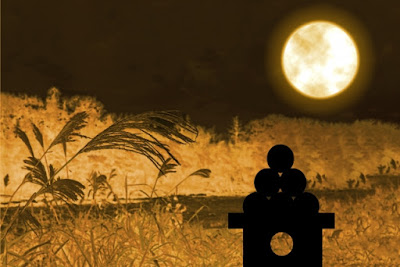Otsukimi: Japan’s Mid-Fall Harvest Moon Festival
*Please note that this article contains affiliate links, which means that your purchasing a product via that link may provide us with a commission. We make it our goal to direct you to products that you will love and that will enhance your wa experience.
There is more and more hype in Japan about Halloween every year. The 100 yen shop and grocery stores pack their shelves with Halloween decorations and candy, bakeries sell special Halloween sweets, and the police department gets an annual headache reigning in the costume-clad youth who cause a ruckus in downtown Tokyo on Halloween night. However, if you have been in Japan during the fall, you will know the older and more traditional celebration that occurs around this time. This mid-autumn festival is called “Otsukimi” (お月見).
Otsukimi means “moon-viewing,” and it started out as basically that–a moon viewing party for rich people.

Where Did Otsukimi Come From?
During the Heian Period, the aristocracy celebrated with lavish cruises, tea parties, and garden parties, where they gazed at the full moon and impressed each other by reciting poetry. The common people, on the other hand, made food offerings to the gods and prayed for a good harvest.
These days some Japanese visit shrines to pray for good health and to give thanks, and you will see storefronts displaying “sasa,” (笹) or pampas grass (resembling the rice plant), autumn flowers, and a pyramid stack of “tsukimi dango,” (月見団子) or rice cake balls made from sticky rice with no sauce.

When Is Otsukimi, 2020?
There are actually two dates for Otsukimi: August 15th, the night of the full moon according to the lunar calendar, called “Jyūgoya” (十五夜) and “Jyūsanya” (十三夜), September 13th, the night of the waxing moon, is a purely Japanese festival, an occasion to give thanks for a good harvest.
Due to the change in calendar, this year’s Jyūgoya is actually Thursday, October 1st, one day before the full moon. The moon on the night of Otsukimi, whether full or not, is said to be the most beautiful and brightest of the entire year. Jyūsanya this year falls on October 29th and is said to be the second most beautiful moon of the year. Be sure to celebrate both, because celebrating only one, “katamizuki” (片見月), is said to be bad luck!
Did You Know? The 15th night of the 8th lunar month can be called “Chūshū no Meigetsu” 中秋の名月 (chūshū means mid-fall, or mid-autumn)., “Imo Meigetsu” 芋名月 (imo means potato), or Jyūgoya. The 13th night can be called Jyūsanya, “Kuri Meigetsu” 栗名月 (kuri means chestnut), or “Mame Meigetsu” 豆名月 (mame means bean).
How To Celebrate Otsukimi
So how can you celebrate Otsukimi?
Try making dango yourself, following the recipe by Just One Cookbook.
Make a stack of either 12 (for the 12 months of the year) or 15 (symbolizing the fifteenth night of the month) rice cakes, set them on a wooden tray, and place it in a south-facing window. If you are craving a sweet, you can replace the plain dango with sauce-covered dango or "daifuku" rice cake filled with sweet-bean paste (don’t worry–we won’t tell!). You should be able to find daifuku at your local Asian market!
It’s also common to display autumn foods like pears, grapes, persimmons, sweet potato, kabocha (Japanese pumpkin), satoimo (Japanese taro potato), edamame, and chestnuts.
If you’re still feeling a little hungry after having tsukimi dango, vegetables, and fruit, follow the recent trend to cook a dish topped with an egg to symbolize the moon. Popular dishes include Otsukimi soba (raw egg on top of thin buckwheat noodles), Otsukimi udon (raw egg on top of thick wheat noodles), or even Otsukimi burger (hamburger with cooked egg inside)!

Otsukimi 2020
Since Otsukimi is all about enjoying the moon and giving thanks, why not take a moment to gaze out your window with a sweet in one hand and a cup of sake in the other, and recite Japanese haikus about the moon? Even better, why not have an Otsukimi party and think about only the good things that have happened to you in topsy-turvy 2020?
What other Otsukimi dishes can you think of? Did you know about Jyūsanya? What good things happened to you in 2020? Tell us in the comments below!




Wonderful article! I was just thinking yesterday that I want to know a good Japanese festival for the fall, since I'm a total non-fan of the Western ones. I will try to locate shiratama-ko in a hurry and make dango tomorrow! Good I read this in time!
ReplyDeleteI never knew many of the things you wrote about, as usual eheheh. Tsukimi burger is fun and easy to make! I always try to observe full moon every month.
ReplyDeleteAlso, what is that platform called that the dango are on? I know it's used often to hold a special something. Are you supposed to leave the decor out from Jyuugoya till Jyuusannya? (Knowing Japan, I feel like this would probably be back luck and you're supposed to burn the dango or something, haha!)
ReplyDelete